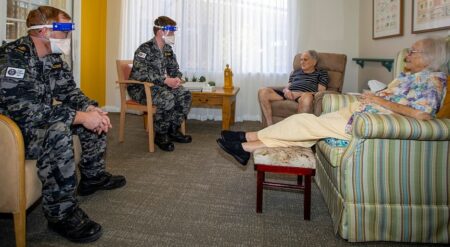IN a photo (above) distributed by the Australian Defence Force (ADF) a Leading Seaman Electronic Technician and a Seaman Electronic Technician are shown as having a chat with two nursing home residents as part of Operation COVID-19 Assist.
As part of Operation COVID-19 Assist, the Government will deploy up to 1,700 ADF personnel “to support staff in the aged care sector”.
Not all of those 1,700 will be electricians, but as the Prime Minister pointed out “the ADF is not a shadow workforce”.
Operation COVID-19 Assist kicked off with the “deployment” of ten Quick Response Support Teams this week with 50 members each.
Operation COVID-19 Assist is wider than residential aged care only.
It has also included quarantine compliance and management, contact tracing, ambulance driving and delivery of food to vulnerable Australians.
However, all those things falling under Operation COVID-19 Assist were to cover emergencies purely down to the COVID-19 pandemic.
Staffing in nursing homes was at an emergency level long before the COVID-19 virus even existed. Back then, as now, nursing homes generally paid wages as low as they could make them. Many homes employed staff on a casual basis only, cutting out every hour in order to lower staffing costs.
The nursing home industry now says that the Government aged care subsidies are so low that they have no alternative but to screw staffing hours and wages down as much as they can.
And they are right.
Problem is they were already screwing staffing hours and wages down as much as they could when the Government was paying adequate subsidies. At that time, many providers simply were looking to maximise profits.
When the Government cottoned on to that fact, it started to reduce subsidies.
What the Government neglected to do was to insist that its subsidies be spent on staffing.
However, that would have meant getting aged care providers to acquit the subsidies they received and show that they had spent that funding on wages. There was and is no legislated mechanism for that.
So, the nursing home staffing crisis escalating to the point of having electricians being sent in to care for residents is entirely of the Government and industry’s own making.
In a sign that both the Government and the industry will not learn from even mistakes as big as this, the special $10-a-resident-a-day subsidy to improve nursing home food has generally not led to better food being served.
There is no requirement to this special subsidy. As a result, in many cases it’s being used for other things or to increase profits.
Fixing up aged care is going to take a lot more than a bit of fuse wire.
Money for more and better-paid staff.
